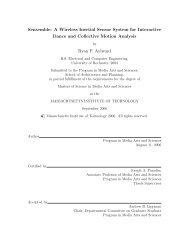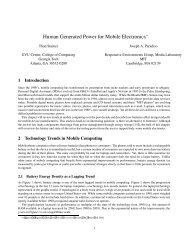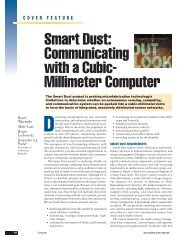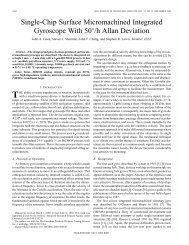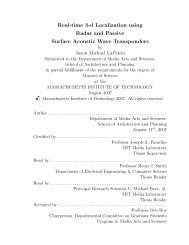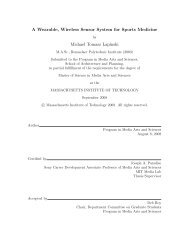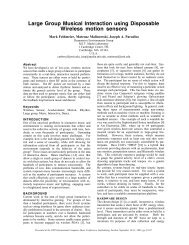S.N.A.K.E.: A Dynamically Reconfigurable Artificial Sensate Skin ...
S.N.A.K.E.: A Dynamically Reconfigurable Artificial Sensate Skin ...
S.N.A.K.E.: A Dynamically Reconfigurable Artificial Sensate Skin ...
You also want an ePaper? Increase the reach of your titles
YUMPU automatically turns print PDFs into web optimized ePapers that Google loves.
whisker is epoxied to the package of the sensor. For this to be possible the whiskers have to<br />
strain the package enough for the sensor to respond, which is easily obtained if the whiskers<br />
are thick and stiff enough, and enough gain is given to the amplifier.<br />
The circuit necessary for its signal conditioning depends directly on the type of information<br />
that is desired. Vibration, strain, shock or simply activity can all be derived from this sort<br />
of sensor depending on the signal conditioning and sampling chosen. A very detailed review<br />
of possible circuit options are shown in the Measurement Specialties Piezo Film Technical<br />
Manual [63]. Since the idea of including whiskers was mainly to detect the presence of<br />
close activity, a very simple circuit was used to generate vibration pulses, which are then<br />
connected to an input pin of the microcontroller, which can then either extract the vibration<br />
frequency, or simply report if there was or no activity for a certain period of time. This is<br />
also shown in Appendix C.<br />
Ambient Light<br />
Although one might not notice the fact that our skin is indeed capable of sensing ambient<br />
light, this becomes clear if we take into consideration that it is light and not heat which<br />
causes the familiar melanin concentration change in the skin when we spend long times<br />
under the sun; in other words we get tanned because of the amount of light received by our<br />
skin. Some animals (e.g. Cattlefish have optical sensors distributed in their skin).<br />
Including an ambient light sensor into the nodes would allow several applications to be<br />
developed with the network. Some possibilities include the retina-like light edge detection<br />
system presented by Lifton in his push-pin distributed-computing-platform [39], and light<br />
gradient and source direction detection, and longrange proximity detection by cast shadows.<br />
This capability was implemented by adding a Toshiba TPS851/52 ambient light sensor,<br />
shown in Figure 3-19. This tiny device was created as an illuminance sensor for brightness<br />
control of mobile device displays, and it is based on a current-amplified photodiode. It is an<br />
ideal option for the <strong>Skin</strong> Nodes because it doesn’t need any external amplification, which<br />
reduces component count. It also has a low supply-voltage and power consumption that<br />
70





